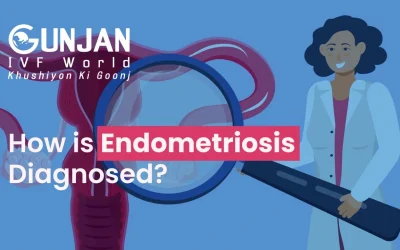Adenomyosis and endometriosis are both common conditions, they is not unusual. Endometriosis is also present in around 40% to 50% of women with adenomyosis.
What is endometriosis?
Endometrium is a group of cells that make up the womb’s lining. The presence of endometrial tissue on other organs, generally within the pelvic cavity, is known as endometriosis.
Outside of the womb, endometrial tissue functions similarly to that inside the womb. It starts to pile up, then starts to leak away. Menstruation is the result of normal endometrial tissue inside the womb leaving the body. Unfortunately, it cannot exit the body when it bleeds outside of the womb and so builds up, causing pain and discomfort.
Endometriosis most often affects the ovaries. Other tissues, such as the uterosacral ligaments that support the womb, may be implicated. Organs including the Fallopian tube, bladder, and intestine, which may interfere with bowel, bladder, and sexual function, might also be impacted. Occasionally, the belly button and scar tissue left in the abdomen from prior interventions may involve other afflicted regions.
In extreme situations, tissues such as the bowels and womb might grow such that they merge pelvic organs.
What is Adenomyosis?
Adenomyosis is a medical disease in which the cells that make up the uterine interior (endometrium) develop atypically inside the cells that make up the uterine wall (myometrium), resulting in increased uterine thickness. Endometrial tissue is entirely functioning, even though it is displaced in people with this disease. During a menstrual cycle, the tissue thickens, sheds, and bleeds.
Patients with endometriosis have endometrial tissue that is improperly placed totally outside the uterus, whereas adenomyosis has endometrial tissue that is incorrectly situated entirely inside the uterus. In many situations, the two diseases co-occur, but they also happen on their own.
20+ Years Of Experience as Fertility Specialists
20 Years Of Experience as a Fertility Specialists
National Fertility Awards 2023
Call Us
+919990044555
Difference between Endometriosis and Adenomyosis
In some respects, adenomyosis is similar to endometriosis, but it has different origins and acts differently. Adenomyosis occurs when endometrial tissue develops abnormally, similar to endometriosis. Endometrial-like tissue grows outside of the uterus (usually on the fallopian tubes, ovaries, and/or exterior surface of the uterus) in endometriosis, whereas endometrial tissue grows inappropriately into the muscular wall of the uterus in adenomyosis (called the myometrium).
Adenomyosis causes discomfort in women in the same way as endometriosis does (because the abnormal tissue swells and bleeds but cannot exit the body). Adenomyosis affects the proper functioning of the uterus muscle by developing into the uterine wall. It can also cause excessive bleeding and infertility.
Many women with endometriosis also have adenomyosis, according to studies. In one research, 78 percent of women with endometriosis also had adenomyosis.
Adenomyosis is characterized by the following symptoms:
- During your period, you may have heavy or prolonged bleeding
- During your period, you have severe cramps or acute sensations
- Pelvic discomfort that persists
Book An Appointment
Follow Us On
FURTHER READING
Conclusion
Endometriosis and adenomyosis have unidentified causes. Genetic and immunologic factors are both risk factors for endometriosis. Adenomyosis has a different set of risk factors than endometriosis. Being middle-aged, having given birth, and having undergone invasive uterine surgery such as a caesarean section (C-section) or fibroid excision are all risk factors for adenomyosis.
Gunjan Gupta is a well-known specialist in endometriosis who you can consult if you are suffering from it. Dr. Gunjan Gupta offers comprehensive Endometriosis treatment using the latest medical equipment. The doctor has many years of experience treating Endometriosis in Delhi.
Share this with
Related Blogs
Natural Remedies For Endometriosis
Endometriosis is a condition in which the tissue that lines the uterus (endometrium) grows outside of the uterus. This can cause pain, inflammation, and scarring. Endometriosis most commonly affects women of childbearing age, but it can occur at any age.
How is Endometriosis Diagnosed ?
The endometrium is the tissue that lines up in the wall of the uterus. After every twenty-eight days, this tissue breaks down and bleeds as menstrual blood.
Follow Us On
About Author





